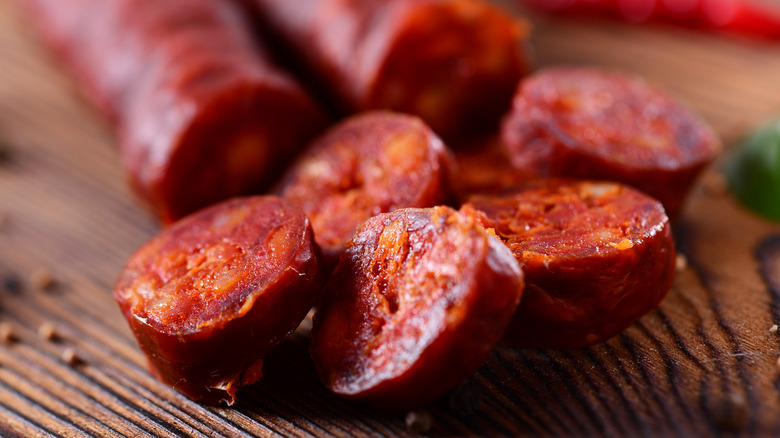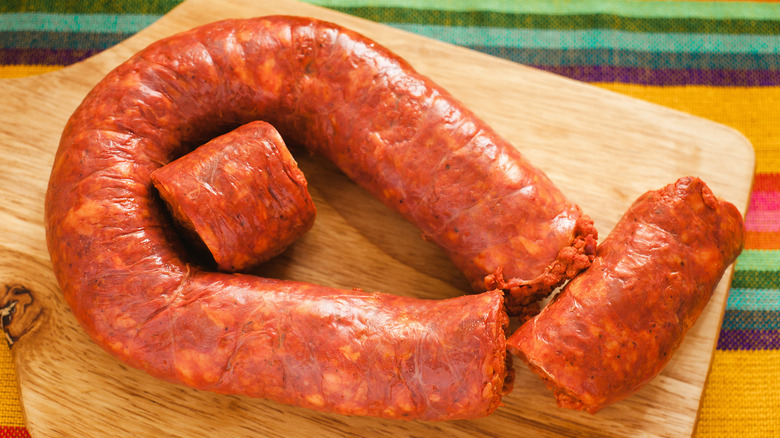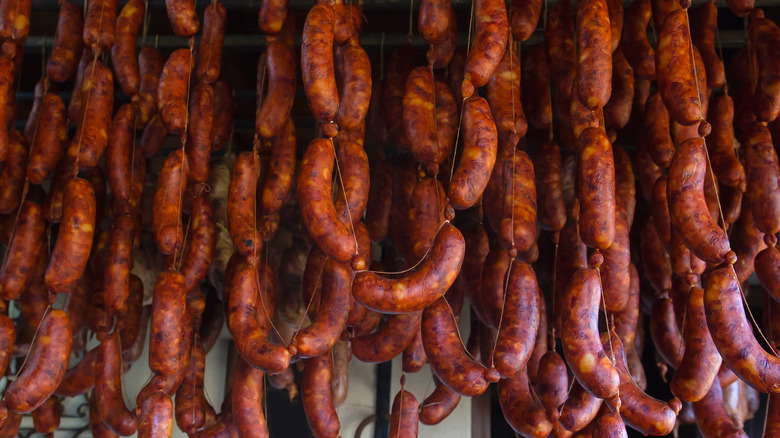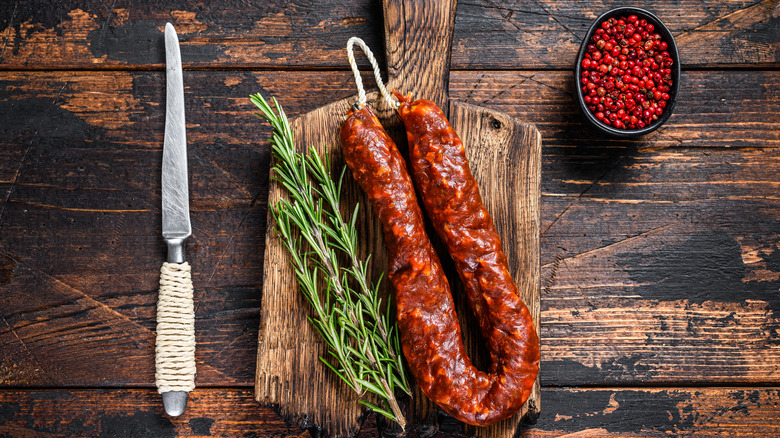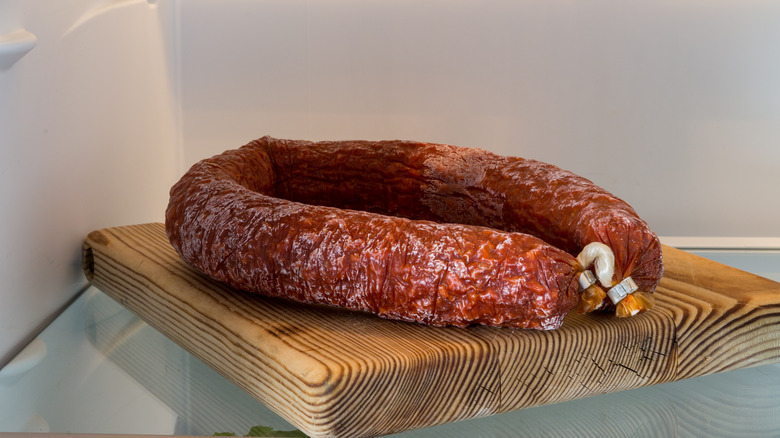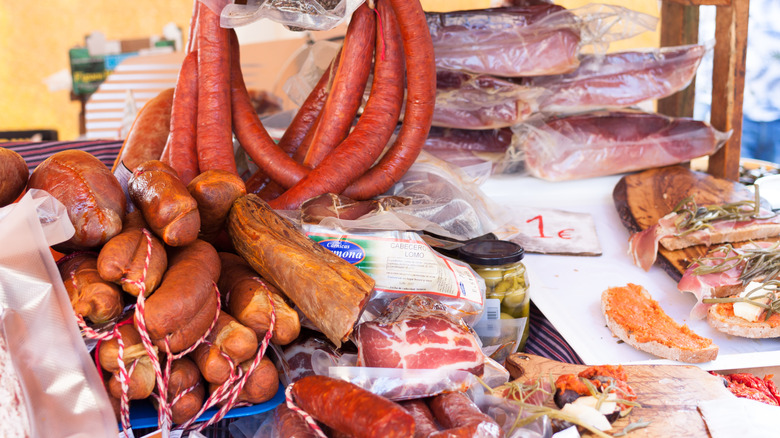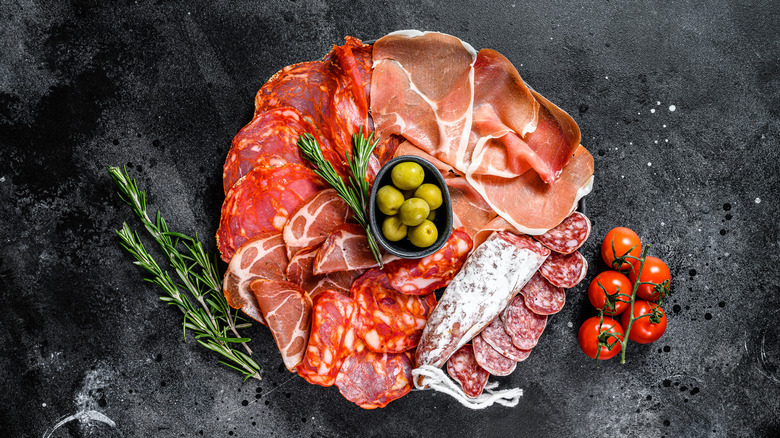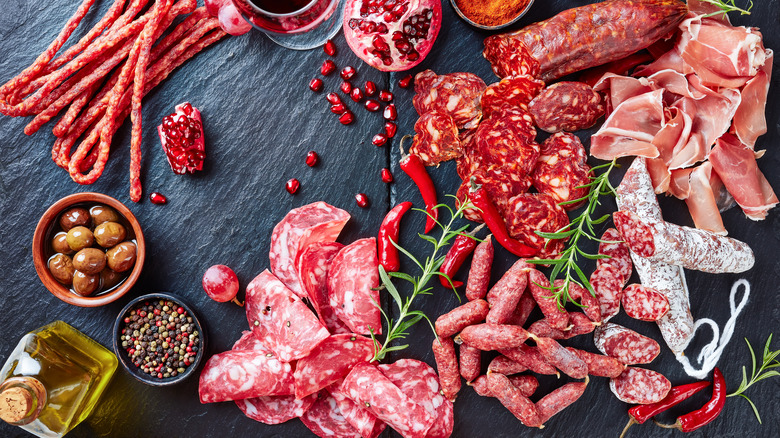What Is Chorizo And How Is It Made?
Maybe you noticed the word on a brunch or dinner menu, came across it listed in a recipe, or spotted it while browsing the aisles of your favorite grocery store. But what exactly is chorizo and how is it made? At first glance, chorizo is pretty obviously sausage. Macayo's Mexican Food explains that the term chorizo simply refers to spiced pork sausage. They claim that while there are many different types of chorizo, the two most popular and common varieties you will come across are Mexican chorizo and Spanish chorizo.
The Kitchn notes Mexican chorizo can be purchased fresh and uncooked, either ground or in a casing. They state that Spanish chorizo is sold dried or cured in a casing. Spanish chorizo can be either smoked or unsmoked and comes in both spicy and sweet varieties. Both varieties are usually reddish in color, a result of the mix of spices used to make both types of chorizo.
How Mexican chorizo is made
Mexican chorizo is usually made with ground or minced pork. However, variations do exist, and it is sometimes made with ground beef, chicken, turkey, or venison. Vegetarian and vegan versions made from soy also exist. The addition of dried chili peppers, typically Guajillo, New Mexican, and Ancho chili, is what gives Mexican chorizo its vivid red color (via Mexican Please). But the way they're combined can vary quite a bit. Other common additions include pork fat, vinegar, and other spices, especially aromatic spices like cinnamon and cloves (via Chowhound). There is also a type of Mexican chorizo to which large amounts of cilantro are added, making it green in color (via Macayo's Mexican Food).
After the seasoning has been added, Mexican chorizo is formed into relatively short links, which are then stuffed into casings and left to air dry and age for somewhere between a day and a week, which helps the flavors reach their full potential (via Mexico in My Kitchen).
How Spanish chorizo is made
Spanish chorizo is usually a cured and hard sausage made from coarsely chopped pork. It is often made from cuts of pork such as the loin, jowl, belly, and sometimes the shoulder, though it always contains back fat for its rich fat content (via Masterclass). Spanish chorizo gets its bright red color from pimentón (Spanish paprika), which can either be sweet or hot and spicy. Pimentón grown in the city of Murcia is sun-dried, while that grown in the la Vera region is dried using a wood fire, giving it a distinctive smokey flavor (via Our Daily Brine). Garlic, herbs, and white wine are often included as part of the ingredient mix for Spanish chorizo (via The Spruce Eats).
Depending on the style, Spanish chorizo can be formed into both short and long links. It is then air-dried from a few days to a few weeks or even months, with the length of curing affecting the firmness of the chorizo. Some varieties of Spanish chorizo are also fermented or smoked before being cured.
What does chorizo taste like?
Although Mexican and Spanish chorizos are quite different from each other, they both offer intense flavors from the rich seasonings that they are made with. Those flavors depend on the particular mix of seasoning, which can vary significantly. With Mexican chorizo, the meat or meats that it is made from will also impact the flavors. While pork is the most common, beef or a combination of pork and beef, as well as other meats, or even soy can also be found. The blend of chilis will also affect the taste, as well as how spicy the chorizo is. The aromatic spices that it is often made with will also add a warm and rich flavor, while the vinegar adds a bit of tang.
Since Spanish chorizo is made with pork and pimentón, the type of pimentón used will impact the flavor profile. Pimentón la Vera is the most common type used, which gives the chorizo a smokey flavor, while those made from pimentón grown in Murcia have a more vegetal flavor. The chorizo can be mild and slightly sweet, or hot to varying degrees of spiciness. Spanish chorizo has a dense texture that's almost chewy (via The Kitchn), though that will be affected by how cured it is.
How to cook with chorizo
Epicurious asserts that even though the two types of chorizo do look similar, you need to make sure you know which type of sausage you need before you start cooking, as they are not exactly interchangeable. You cannot substitute raw Mexican chorizo for semi-cured Spanish chorizo, but in a pinch, you would be able to swap dry Spanish chorizo for semi-cured Spanish chorizo, although they do not advise it if you can avoid it.
Since it's already cooked, Spanish chorizo can be eaten as is, including the casing. It's often served in tapas in Spain and goes quite well with manchego cheese. It can also be diced up, fried in a pan, and added to soups, paellas, or seafood dishes for added richness and flavor. Generally, Spanish chorizo with higher fat content is used for cooking, while leaner versions are sliced and eaten as is (via The Spruce Eats).
Mexican chorizo is raw and needs to be cooked first. If it's sold in a casing, remove the casing before cooking and crumbling the meat in a pan. It's often served with scrambled eggs for breakfast or used in dishes like tacos, tortas, and tostadas. Given its strong flavor profile, it usually doesn't need additional seasoning (via Chowhound). It will also usually release a lot of oil.
How to store chorizo
Since chorizo is so flavorful, you don't need to use a lot of it, which means you may end up with leftovers. According to Freeze It, fresh (i.e., Mexican) chorizo can last in the refrigerator for seven days if it has been opened or removed from its casing, and two weeks if still in its original packaging, while both opened and unopened packages will last for up to 12 months in the freezer.
According to The Black Hoof, cured (i.e., Spanish) chorizo that's been vacuum-sealed can last for 90 days before opening and should be kept in a cool dry place like a pantry or cupboard. Once opened, store the chorizo in the refrigerator, and use it within a few days. A whole chorizo is more exposed to the elements and will dry out, which is why you should consume it within a month. It's best to hang the whole chorizo in a cool dry place or to cut it into sections wrapped in plastic wrap. It can be stored in the refrigerator, but it's recommended to let the chorizo warm up to room temperature before serving. Spanish chorizo, like other cured meats, should not be stored in the freezer, as it can damage the fibers and texture of the meat and change the flavors.
Where to buy chorizo
Given how versatile chorizo is, and the many different ways you can use chorizo in a dish, you'll probably want to run out and grab a whole bunch for the next time you're making breakfast, lunch, or dinner. So where should you go to find chorizo? Well, a lot of that depends on what type of chorizo you're shopping for.
Since Mexican chorizo is raw, you'll want to check the refrigerated meats section of your local supermarket, where you'll find sausage and other raw meats (via The Spruce Eats). They're usually sold in a package of five links. Since there is quite a range in ingredients that go into chorizo, you may want to check other markets if you want to find different brands with different flavors. Head to a Latin market if you want to find special varieties like Longaniza. Spanish chorizo, on the other hand, can usually be found with other ready-to-eat and cured meats like salami or pepperoni at your local supermarket, either whole or sliced. You can also find them at specialty stores and online.
Chorizo's nutritional information
Given that it's a type of sausage made from fatty cuts of meat, it's not surprising that chorizo is high in calories, fat, and sodium. According to SF Gate, there are 273 calories in just one 4-inch link of chorizo. That's largely thanks to the 23 grams of fat it contains, 8.6 grams of which are saturated fat. Soy chorizo is an alternative if you are looking for something with less fat, as it can have up to 60% less fat compared to Mexican chorizo (via The Kitchn). However, chorizo is high in protein and low in carbs and can be eaten as part of a keto diet (via Chomps).
Chorizo does contain some essential vitamins, as SF Gate points out, including thiamine, riboflavin, niacin, vitamin B-6, and vitamin B-12. Livestrong notes that Spanish chorizo is also a good source of selenium, while Nutrition Advance adds that Spanish chorizo also contains zinc, potassium, and vitamins D, K, and E, and is a source of probiotics.
Other varieties of Spanish chorizo
While most Spanish chorizo that Americans are familiar with is cured, there are actually four categories of Spanish chorizo. Picadillo, or loose chorizo, is a ground-meat variety that is similar to Mexican chorizo and typically fried. Fresco, or fresh chorizo, is like picadillo except that it's stuffed in a casing. Semicurado, or semi-cured chorizo, is fermented and sometimes smoked without being dried. And curado is the cured chorizo most commonly found in America (via Our Daily Brine).
There are also different varieties of Spanish chorizo based on where they are made, which also affects what they are seasoned with. Chorizo riojana is made in Rioja, Spain, and seasoned with spicy and sweet pimento along with garlic. Spanish chorizo castellano is similar to chorizo riojano but also includes oregano. Spanish chorizo navarra contains sweet pimento and garlic. And Spanish chorizo andaluz gets its flavoring from pimento, cloves, garlic, black pepper, and dry white wine (via MasterClass).
